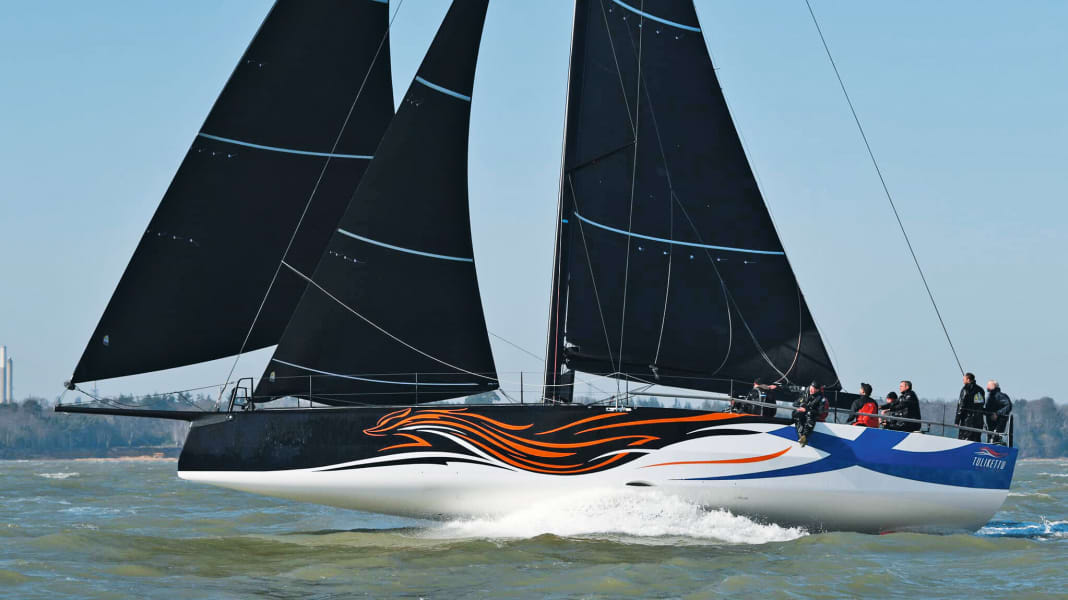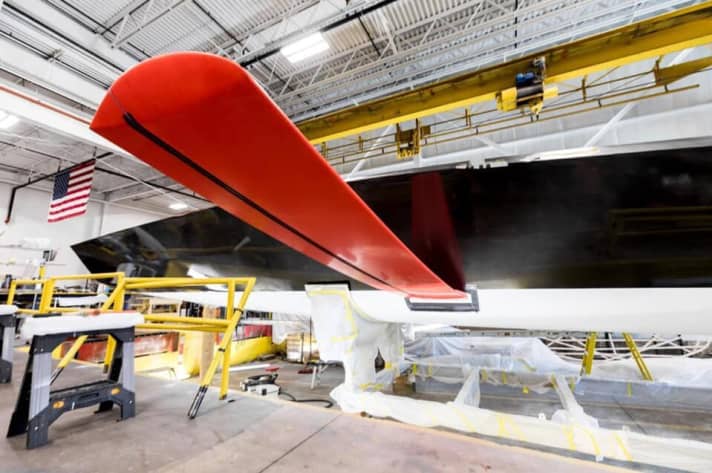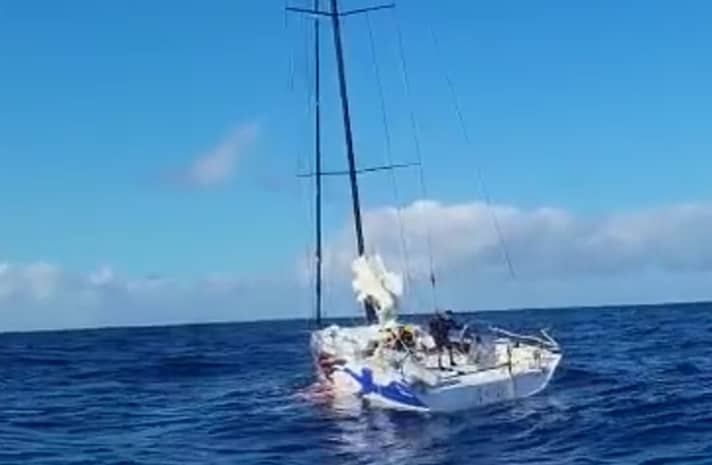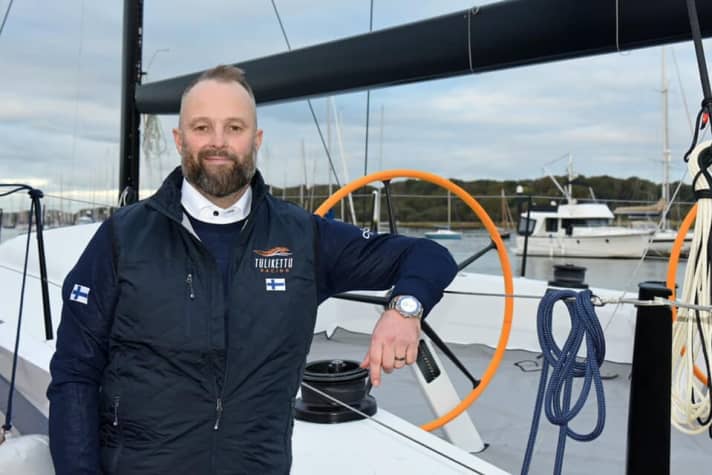
"Tulikettu" sailed from Cascais, Portugal, back to the team base in Gosport, England, across the Bay of Biscay. The DSS foil, which can be extended in one piece in the boat from side to side to create righting moment, was reportedly retracted when the hull struck an unidentified floating object on Monday 18 April. According to reports from the crew, there was an uncontrolled leak in the boat, the cause of which was unknown. The crew triggered the Epirb distress transmitter after midnight on Wednesday 20 April. The four-man crew attempted to stop the water ingress. Two of the crew members were experienced boat builders. After ten hours, during which a rescue ship also reached the scene of the accident, it was temporarily ensured that the ship would not sink. The team was about 300 nautical miles off the coast
When the rescue ship, an oil tanker, arrived, there was a lot of water in the boat. Not knowing if the latest repairs would work, the crew had two options: wait to see if the repairs worked or abandon the boat. The weather conditions worsened, with high waves. The difficult decision was made to evacuate to the oil tanker to ensure the safety of the crew on board, as the logistics company had ordered the tanker to leave the area as soon as possible due to the worsening sea state. No one was injured in the accident. The search for "Tulikettu" was suspended on Saturday 30 April.

"Tulikettu" was abandoned off the coast of Portugal. The boat was to take part in the world's largest offshore sailing competitions. It was not known whether the crew's efforts had worked. A new sighting of the boat was received on Monday 23 May. The boat was spotted by a passing yacht, and the crew contacted the Tulikettu social media channel via a private message. When the message proved to be reliable, the rescue operation was immediately resumed.

"It was an incredible feeling when we found the boat six and a half weeks after it disappeared," said Arto Linnervuo, skipper and owner of the Tulikettu Racing Team, on Sunday in Portimão, Portugal. "Here I am, standing on the deck of the boat."
After dozens of hours of flying, countless drift calculations and hundreds of nautical miles of searching by salvage boats, "Tulikettu" was found on Saturday 4 June about 100 nautical miles west of Cape Saint Vincent, the southern tip between Lisbon and Gibraltar. The yacht was towed to the port of Portimão on Sunday 5 June, where it will undergo a thorough inspection and assessment of the damage.

"The story finally had a happy ending. Saturday was one of the happiest days of my life. There was an incredible rescue operation that supported this effort, involving more than a dozen top professionals from Finland, England, Portugal, Spain and the United States. I am particularly proud that the rescue operation was led by my own Tulikettu Racing Team, who were flown in to help on the ground," says Linnervuo, who was on board the spotter plane.
Linnervuo made the final sighting that led to the ultimate rescue of the boat. He transmitted the position from the aircraft to the tug at sea using a VHF radio. Locating and rescuing a black boat with no transmission signals that had travelled as far as 100 nautical miles off the coast to the east was a very difficult task. The rescue vessel had to be close to the last sighting to ensure a safe recovery, as "Tulikettu" was drifting very unpredictably unattended.
"Both things were successful on Saturday," says Linnervuo.
Following the renovation and repairs, "Tulikettu" is expected to resume its ambitious racing schedule.
"Externally, the boat showed no damage and the mast was upright. It shows how well these boats are designed and built. The extent of the damage will become clear in time," says Linnervuo.
"Tulikettu" during trial runs with 28 knots of speed
Gordon Kay, founder of Infiniti Yachts, was on board for the rescue tow. "We are delighted to have been instrumental in bringing 'Tulikettu' back into the team. We look forward to seeing her on the racecourse soon. It is a testament to her design and construction that she has come through this with such aplomb."
The aim of the Finnish project is to win one of the biggest offshore races in the world. In addition, Linnervuo's goal is to win the overall class championship for the Royal Ocean Racing Club's Offshore Sailing Series (RORC) in 2022 or 2023.
"Tulikettu" is the first Infiniti 52 yacht, built by Composite Builders in Michigan, USA. The designer is Briton Hugh Welbourn, a pioneer in the development of DSS foils. The hull, mast and rigging of "Tulikettu" are made of carbon fibre, resulting in a target weight of less than 7,000 kilograms, which is extremely light for a 52-foot sailing yacht. Infiniti 52 also claims to be the first yacht designed and engineered to maximise the competitive advantage of Doyle's wireless sailing technology. With only half the forestay loads of a typical modern 52-footer, there is scope for dramatic weight savings in all hull and rig structures. The boat's unique feature is the one-piece patented DSS (Dynamic Stability System) foil, which slides from side to side through the hull of the boat.
According to the team, the Infiniti 52 is the first monohull offshore racing boat in which the foil and its advantages have been used as the starting point for the entire yacht design. The foil generates buoyancy as it pulls through the water. The result is the lifting of the hull, reduced drag and, above all, an increased righting moment. This makes it possible to design the boat narrower and thus reduce the weight. By adding water ballast and electrically driven winches, further weight savings are achieved by reducing the crew weight.

